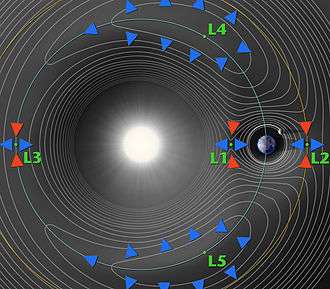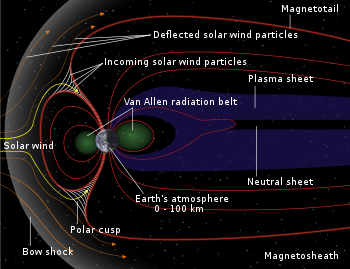Lagrange point colonization
Lagrange point colonization is the colonization of the five equilibrium points in the orbit of a planet or its primary moon, called Lagrangian points. The most obvious such points for colonization are those in the Earth–Moon and in the Sun–Earth systems. Although it would generally take days or weeks to reach the latter with current technology, it would be possible to generate energy from sunlight at them nearly continuously since they would, due to their considerable distance from Earth, be shaded from the Sun only seldom and then only shortly.
| Space colonization |
|
Earth–Moon

The only two stable Lagrange points are L4 and L5. Lagrange points are stable if the mass of the larger body is at least 25 times the mass of the secondary body.[1][2]. The Earth is over 81 times the mass of the Moon.[3] The L5 Society was founded to promote settlement by building space stations at these points in the Earth Moon system.
An L1 station would have a number of important functions due to its stationary position between the Earth and Moon. It is in an excellent location to monitor and coordinate communications among various missions on the nearside of the Moon. A vessel launched from L1 could reach any place on the Moon within a few hours to a day. This would make it ideal for crisis management if an emergency occurred on the Moon. Furthermore, it could serve as a way station, especially once built up, and would probably be used to handle tourists and casual visitors to the Moon. A station like this could also serve as a repair center for ships moving throughout the Solar System.
The L2 point, on the far side of the Moon, is completely shielded from Earth by the Moon so radio telescopes placed there would receive much less interference than existing telescopes. Of course, since the Moon is tidally locked, any colony on the far side of the Moon has this same benefit; a lunar facility, however, would suffer from Moonquakes.
Both L1 and L2 require active stationkeeping since neither is fully stable (they are saddle points on the energy landscape). Colonies at the L4 and L5 positions would have the advantage of being stable without any need for stationkeeping, and could be used as a waypoint for travel to and from cislunar space.
In addition, they would significantly reduce the delta-v (velocity change) needed to move from one to another, or to enter or leave Earth orbit, an important drawback of any lunar surface station, which demands high energy expenditure to escape and a comparable or greater amount to soft-land.
Sun–Earth

The L1 position is useful for solar observations since it is near Earth but in constant sunlight. It could also be useful for collecting solar power. Conversely, the L2 point is perpetually in the shadow of Earth, and as such offers a prime location for observing the outer planets or deep space. L4 and L5 colonies could be used as waypoints in space travel, to expand the practical launch window for travel to and from Earth and the other planets. These positions are useful for colonies as they are stable without any need for stationkeeping.
Disadvantages

The risk of proton exposure from the solar wind as well as the health threat from cosmic rays would be significant. The Earth's magnetosphere protects against solar storms but provides little protection from the more energetic cosmic radiation—the Earth's atmosphere protects us from that.
In the Earth–Moon system, the orbit of colonies at L3–L5 would take them outside the protection of Earth's magnetosphere for approximately two-thirds of the time (as occurs with the Moon). Colonies at L1 (located between Earth and the Moon) would experience this to a lesser degree, whereas L2 (located beyond the Moon) would experience this to a greater degree and all of them would be exposed to the little-understood plasma sheet of the magnetotail.[4]
In the Sun–Earth system, L1 and L3–L5 are all outside the protection of Earth's magnetosphere. L2 periodically transfers from within the magnetotail, plasma sheet, and solar wind, depending on the intensity and direction of the solar wind.
Solar storm shielding would only be needed occasionally and it would also be easier to protect against in a shelter settlers could retreat to during a major storm. Cosmic radiation doses build up more slowly over years of exposure, and would need a couple of meters or more of shielding. Designs for space habitats usually supply this with an external shield of regolith or other materials.
References
- Fitzpatrick, Richard. "Stability of Lagrange Points". Newtonian Dynamics. University of Texas.
- Greenspan, Thomas (January 7, 2014). "Stability of the Lagrange Points, L4 and L5" (PDF).
- Pitjeva, E.V.; Standish, E.M. (2009-04-01). "Proposals for the masses of the three largest asteroids, the Moon-Earth mass ratio and the Astronomical Unit". Celestial Mechanics and Dynamical Astronomy. 103 (4): 365–372. Bibcode:2009CeMDA.103..365P. doi:10.1007/s10569-009-9203-8.
- The Moon and the Magnetotail - Tony Phillips (2008)